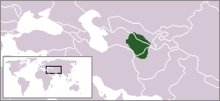Margiana
| Margiana Marv | |
|---|---|
| Provinsi di Kekaisaran Seleukia, Kekaisaran Parthia, dan Kekaisaran Sasaniyah | |
| sekitar 281-261 SM–651 M | |
 Margiana, sekitar 300 SM | |
| Ibu kota | Merv |
| Sejarah | |
| Era sejarah | Kuno |
• Didirikan | sekitar 281-261 SM |
• Dicaplok oleh Kekhalifahan Rasyidin | 651 M |
| Sekarang bagian dari |  Afghanistan Afghanistan Turkmenistan Turkmenistan Uzbekistan Uzbekistan |
Margiana (bahasa Yunani: Μαργιανή Margiane, Bahasa Persia Kuno: Marguš,[1] Bahasa Persia Pertengahan: Marv[2]) adalah sebuah wilayah bersejarah yang terletak di pusat oasis Merv dan merupakan sebuah satrap kecil dalam satrap Achaemenid dari Baktria, dan menjadi sebuah provinsi setelah penguasa penerusnya, Seleukia, Parthia, dan Sasaniyah.
Margiana terletak di lembah Sungai Murghab yang mata airnya bersumber di pegunungan Afghanistan, dan melewati Distrik Murghab di Afghanistan saat ini, dan kemudian mencapai oasis Merv di Turkmenistan kini. Margiana berbatasan dengan Parthia di barat daya, Aria di selatan, Baktria di timur, dan Sogdiana di utara.
Referensi
Sumber
- Asheri, David; Lloyd, Alan; Corcella, Aldo (2007). A Commentary on Herodotus, Books 1-4.
- Bopearachchi, Osmund (1995). "DIODOTUS". Encyclopaedia Iranica.
- Brunner, Christopher (1983). "Geographical and Administrative divisions: Settlements and Economy". The Cambridge History of Iran: The Seleucid, Parthian, and Sasanian periods (2).
- Chabot, Jean-Baptiste (1902). Synodicon Orientale.
- Chiesa, F. (1982). Osservazione sulla monetazione Indo-Partica. Sanabares I e Sanabares II incertezze ed ipotesie.
- Dani, Ahmad Hasan (1999). History of Civilizations of Central Asia: The development of sedentary and nomadic civilizations: 700 B.C. to A.D. 250.
- Farrokh, Kaveh; Frye, Richard N. (2007). Shadows in the Desert: Ancient Persia at War.
- Foltz, Richard (1999). Religions of the Silk Road: Overland Trade and Cultural Exchange from Antiquity to the Fifteenth Century.
- Fowlkes-Childs, Blair (2003). "The Sasanian Empire (224-651 A.D.)". Heilbrunn Timeline of Art History.
- Frye, Richard N. (1983). The History of Ancient Iran.
- Herzfeld, Ernst (1968). The Persian Empire: Studies in Geography and Ethnography of the Ancient Near East.
- Lendering, Jona (1998). "Artaxerxes V Bessus". Livius.
- Lendering, Jona (2000). "Spitamenes". Livius.
- Lendering, Jona (2006). "Alexandria in Margiana". Livius.
- Lendering, Jona (2011). "Margiana". Livius.
- Lerner, Jeffrey D. (1999). The Impact of Seleucid Decline on the Eastern Iranian Plateau: The Foundations of Arsacid Parthia and Graeco-Bactria.
- Lukonin, V. G. (1983). "Political, Social and Administrative Institutions: Settlments and Economy". The Cambridge History of Iran: The Seleucid, Parthian, and Sasanian periods (2).
- Pourshariati, Parvaneh (2008). Decline and Fall of the Sasanian Empire: The Sasanian-Parthian Confederacy and the Arab Conquest of Iran.
- Rawlinson, George (1867). The Seven Great Monarchies Of The Ancient Eastern World, Vol 5: Persia.
- Rawlinson, George (1873). The Seven Great Monarchies Of The Ancient Eastern World, Vol 6: Parthia.
- Rawlinson, George (1875). The Seven Great Monarchies Of The Ancient Eastern World, Vol 7: The Sassanian or New Persian Empire.
- Strabo (1924). H. L. Jones, ed. Geography.
- Wilcox, Peter (1986). Rome's Enemies (3): Parthians & Sassanid Persians.
- Williams, Tim (2012). "Unmanned Aerial Vehicle Photography: Exploring the Medieval City of Merv, on the Silk Roads of Central Asia" (PDF). Archaeology International (15).
- Young, Jr., T.C. (1988). "The consolidation of the empire and its limits of growth under Darius and Xerxes". The Cambridge Ancient History.
Koordinat: 37°36′N 61°50′E / 37.600°N 61.833°E / 37.600; 61.833









